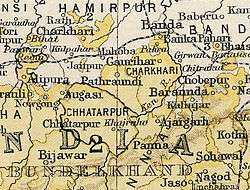Bijawar State
| Bijawar State बिजावर | |||||
| Princely State | |||||
| |||||
|
Coat of arms | |||||
 | |||||
| History | |||||
| • | Established | 1765 | |||
| • | Independence of India | 1950 | |||
| Area | |||||
| • | 1901 | 2,520 km2 (973 sq mi) | |||
| Population | |||||
| • | 1901 | 110,500 | |||
| Density | 43.8 /km2 (113.6 /sq mi) | ||||
| | |||||
Bijawar State was a princely state of colonial India, located in modern Chhindwara district of Madhya Pradesh.[1]
The native state of Bijawar covered an area of 2520 km² (973 sq. m.) in the Bundelkhand Agency. Forests covered nearly half the total area of the state, which was believed to be rich in minerals, but lack of transport facilities had hindered the development of its resources.
History
The state takes its name from the chief town, Bijawar, which was founded by Bijai Singh, one of the Gond chiefs of Garha Mandla, in the 17th century. The first ruler of the state was Bir Singh Deo (1765–93), a Bundela Rajput descended from the ruler of Orchha. It was conquered in the 18th century by Chhatarsal, the founder of Panna, a Rajput of the Bundela clan, by whose descendants it is still held.[2]
Bijawar became a British protectorate on 27 Mar 1811 and the rule of the territory was confirmed to Ratan Singh in 1811 by the British government for the usual deed of allegiance. In 1857 Bhan Pratap Singh rendered signal services to the British during the Revolt of 1857, being rewarded with certain privileges and a hereditary salute of eleven guns. In 1866 he received the title of Maharaja, and the prefix Sawai in 1877. Bhan Pratap was succeeded on his death in 1899 by his adopted son, Sanwant Singh, a son of the Maharaja of Orchha.[3][4]
The state acceded to India on 1 January 1950, and became part of the state of Vindhya Pradesh, which was merged into Madhya Pradesh on 1 November 1956.
Rulers
The rulers of the state belonged to the Bundela dynasty.
Rajas
- 1769 – 1793 Bir Singh Deo (b. ... – d. 1793)
- 1793 – 1802 Himmat Bahadur
- 1802 – Dec 1810 Keshri Singh (b. ... – d. 1810)
- 1811 – 1833 Ratan Singh
- 1833 – 1847 Lakshman Singh
- 23 Nov 1847 – 1866 Bham Pratap Singh
Maharajas (title from 1877 Sawai Maharaja)
- 1866 – 15 Sep 1899 Bham Pratap Singh
- Jun 1900 – 30 Oct 1940 Savant Singh (b. 1877 – d. 1940)
- 30 Oct 1940 – 15 Aug 1947 Govind Singh (b. 1934 – d. 1983)
See also
References
- ↑ David P. Henige (2004). Princely states of India: a guide to chronology and rulers. Orchid Press. p. 22. ISBN 978-974-524-049-0.
- ↑ Rajput Provinces of India - Bijawar Princely State
- ↑
 One or more of the preceding sentences incorporates text from a publication now in the public domain: Chisholm, Hugh, ed. (1911). "Bijawar". Encyclopædia Britannica. 3 (11th ed.). Cambridge University Press. p. 928.
One or more of the preceding sentences incorporates text from a publication now in the public domain: Chisholm, Hugh, ed. (1911). "Bijawar". Encyclopædia Britannica. 3 (11th ed.). Cambridge University Press. p. 928. - ↑ Princely state - Bijawar
Coordinates: 24°38′N 79°30′E / 24.63°N 79.5°E
